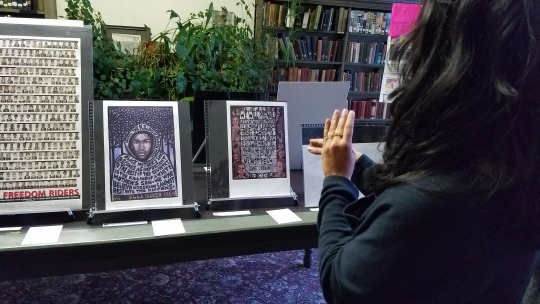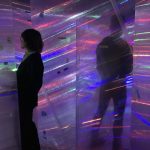Creative Careers | Tools for Creative Activism from Curatorial Organizer La Tanya S. Autry
“My real talk: Believe in yourself. You have a right to be there.” – La Tanya S. Autry
As a cultural organizer in the visual arts, La Tanya S. Autry focuses on social justice and public memory in her work. In addition to co-creating The Art of Black Dissent, an interactive program that promotes public dialogue about the African-American liberation struggle, she co-founded the #MuseumsAreNotNeutral initiative, which calls for an equity-based transformation of museums, and the Social Justice and Museums Resource List, a crowd-sourced bibliography. Autry can be found online with the project name Artstuffmatters on WordPress, Twitter, and Instagram.
We spoke with Autry about her vision for the future of museums, the power of social media for artists, curators, and organizers, and the ways in which we can all lead and push for change.
NYFA: What prompted you, along with Mike Murawski, to launch the “Museums are Not Neutral” campaign?
La Tanya S. Autry: Our #MuseumsAreNotNeutral initiative grew from a shared concern about the dominance of the neutrality claim in the field. In my own experience, I have encountered art museum professionals, with advanced level degrees, making statements such as “the museum has to be neutral” or “we can’t be political” to deflect calls to address racism. Those assertions are false because they decontextualize the origins and practices of museums. While Murawski and I do not suggest institutions adopt partisan views, we wanted to make a clear stand against the myth of neutrality. We also wanted to encourage more people in the field, as well as visitors, students, educators, and others, to acknowledge the truth. Since August 2017, when we launched our campaign which supports community-centered social progress, hundreds of people in the U.S. and abroad have joined us. As all the profits from sales of our “Museums Are Not Neutral” shirts go to charitable organizations, our global initiative has raised over $13,000, while sparking much needed public discussion about the histories, functions, and possibilities of museums.
NYFA: How do you use social media in your activism and career?
LSA: Years ago I participated in a workshop on public engagement strategies at the University of Delaware, where I am completing my doctorate in art history. Through that program, I started using social media as a means for sharing my research beyond academic spaces. That role is still important to me; however, I quickly found that these digital networks are useful for thinking and planning in public. For me, Twitter, Instagram, and other platforms have been instrumental tools for expanding my knowledge and collaborating with various artists, educators, museum professionals, and others who are committed to the arts, the humanities, and social progress. The Social Justice and Museums Resource List, an open crowd-sourced bibliography of over 40 pages, is one of the collaborative projects that I have developed through engagement with social media.
For inspiration, I’d like to share some of my favorite initiatives, makers and thinkers, and organizations. You can refer to this Twitter list to find those who are active on that platform. Many of the accounts that inspire me are present on Instagram as well as Twitter, though some are only present on Instagram, like Bisa Butler, Delphine Adama Fawundu, Toyin Ojih Odutola, The Black School, and Erykah Antiy Killmonger. Additionally, you can follow the hashtags #BlkTwitterstorians, #1960Now, #SlaveryArchive, #MuseumsRespondToFerguson, and #MASSActionMIA.
NYFA: What kind of museum space should the cultural sector work towards?
LSA: There are important measures underway to make museums more welcoming spaces to broader demographics. I’d love to see more of a central focus on equity, which calls for structural change. An equity-based approach would identify and dismantle the power relations that have created inequalities in museums. This focus addresses root causes, not only the symptoms.
I believe that having more museum board members and executive staff who are committed to anti-racism and anti-oppression could promote deep change and foster caring environments. Here, I’m thinking of hiring practices and training opportunities, as well as functions related to collections, exhibitions, programs, interpretation, conservation, editorial, accessibility, development, and security. Also, the field would experience substantive positive change if more museum professionals and philanthropic organizations recognized and financially supported the longstanding anti-racist, anti-oppression work that many ethnic-specific institutions have done over the years.

NYFA: You’ve said on the podcast Museopunks that if we see ourselves as creative agents for change we can make that change happen in many small ways, and can encourage other people to do that work. What are some ways to make change and mobilize others?
LSA: Yes, I think individual efforts are just as vital as institutional changes. Each of us can educate ourselves by engaging with the histories of the field, reading literature about current practices, social justice histories, theories, and practices. Listening to, citing, and supporting the perspectives of Indigenous, Black, Latinx, Asian, LGBTQ, and disabled communities are important pathways. Collaborating and building solidarity across racial, ethnic, class, gender, and other social forces is necessary for seeing beyond existing frameworks. No matter our status level, we can each be a leader of change, and we can share our experiences with others through public presentations, publishing blog posts and articles, and posting reflections and resources via social media. While “going public” helps us find collaborators, we also learn more about the field and methods for generating social change. It empowers us.
NYFA: What’s your advice for those entering the curatorial field, especially if they identify with a group, or groups, widely underrepresented in the field?
LSA: When I started taking classes in museum studies and working in the field, no one mentioned the difficulties I might encounter as a Black woman from a working class background going into the predominately white and economically-privileged world of art museums. So I am always happy to assist others entering this arena.
I don’t use the word underrepresented as it’s misleading. Instead, I use the term historically excluded as Simone Austin, an MA student in history at the University of Delaware, suggested in a tweet last spring. The problem has not been that people of color and other groups have not shown up. We’ve been excluded from the field for a long time. In addition to being mindful of the language we employ because it shapes our thinking and actions, it’s crucial to study the history of museums. We need to know what came before, what’s happening now, what the visions for museums are, and who’s shaping the field. People who are from groups who have been excluded need to brace themselves for racism and other biases. These things shouldn’t happen, but they do.
My real talk: Believe in yourself. You have a right to be there. Connect with people across the institution in various roles and in the broader community. Analyze biases so you can both deconstruct and address them. Spend time dreaming about what you’d like to create. Strategize the steps needed to actualize your vision. Figure out who can help you get there. Value your relationships with people. Search for respectful and kind mentors who care about your well-being and professional development. Always remember your communities. Find ways to welcome them and others in the museum sphere.
– Interview conducted by Mirielle Clifford, Program Officer, Online Resources
This post is part of a regular blog series, NYFA Creative Careers. Find new and exciting career and artist opportunities on NYFA Classifieds. To read more articles on building your professional artist career, visit the Business of Art section of NYFA’s website. Sign up for NYFA News and receive artist resources and upcoming events straight to your inbox.
Images: La Tanya S. Autry and Mike Murawski, Museums Are Not Neutral, August 2017, composite Instagram image, August 2018, Courtesy: La Tanya S. Autry; and La Tanya S. Autry and Gabriella Svenningsen, The Art of Black Dissent, 2017, Institute Library, New Haven, CT, featuring works from left to right: Eric Etheridge, 1961 Freedom Riders, 2010, print; Ricardo Levin Morales, Trayvon Martin, digital print, 2013; Ricardo Levin Morales, We Are the Mainstream, digital print, 2014; Photo Courtesy: La Tanya S. Autry.





